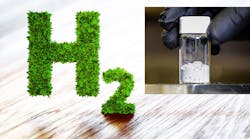Hydrogen is a useful fuel for military and commercial applications—when it is available. Recently, the Army Research Laboratory (ARL) developed a novel nanogalvanic aluminum-alloy-based powder that can produce hydrogen simply when it is mixed with water or any other water-based liquid. The structurally stable powder can be safely transported to where hydrogen is needed; it reacts without a catalyst to produce hydrogen gas quickly and with high efficiency.
The nanogalvanic powder (Fig. 1) can be readily produced in large quantities and can produce hydrogen gas (Fig. 2) as part of a straightforward process. “This powder-based alloy includes material that disrupts the formation of an encapsulating aluminum oxide layer, allowing for the continuous production of hydrogen that can be used at the point of need to power a wide range of devices via fuel cells and internal combustion,” said Dr. Anit Giri, a scientist with ARL’s Weapons and Materials Research Directorate. “The powder can be easily manufactured to scale and can be conveniently and safely transported via tablets or vacuum pouches, thus eliminating reliance on high-frequency hydrogen cylinders.”
1. This stable aluminum-alloy-based powder produces hydrogen gas upon mixing with water or water-based liquids. (Courtesy of U.S. Army Research Laboratory)
2. ARL’s Anthony J. Roberts is inflating a balloon with hydrogen produced from a chemical reaction between water and an aluminum nanomaterial powder. (Courtesy of U.S. Army Research Laboratory)
ARL will be posting a Federal Register Notice as well as launching a website to invite companies to submit ideas on how to commercial this technology. ARL is seeking to work with the most appropriate commercial partners and collaborators to help develop this nontoxic, hydrogen-producing aluminum-alloy material.
Researchers from ARL’s Lightweight and Specialty Metals Branch discovered the properties of this material while exploring aluminum alloy materials for other purposes. “The researchers have since demonstrated rapid hydrogen generation rates using powder and tablet forms of the alloy,” said Branch Chief Robert Dowding. “The hydrogen has been shown to be useful for powering fuel cells and is expected to power internal combustion engines.”
Giri explained that the powder is readily producible and quite powerful: “The powder can be made using current manufacturing techniques from either pure or alloyed aluminum.” He noted that 1 kg of the powder can generate hydrogen to produce 4.4 kWh of energy, and that the hydrogen yield from the powder is quite high, and just a matter of minutes after mixing with water.



